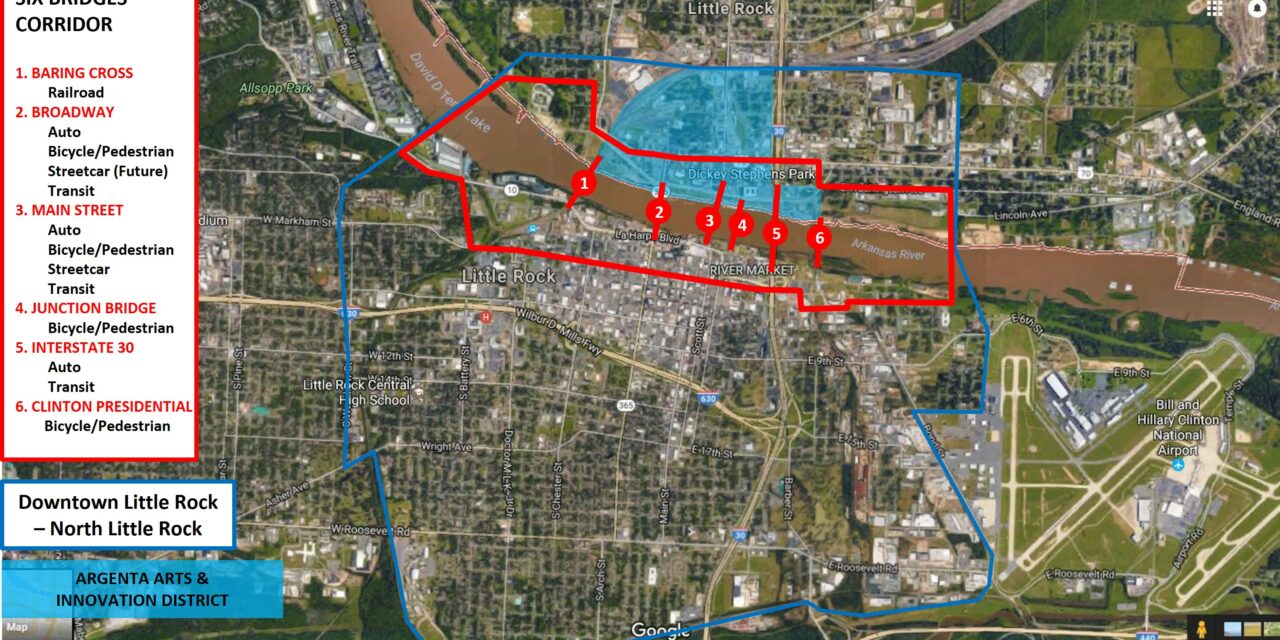North Little Rock’s Second Street Promenade district — the area along the Arkansas River south of Broadway between the Broadway bridge and Interstate 30 — could provide a massive economic development opportunity for Central Arkansas. The ideas are there; what’s needed is a concerted commitment by public and private investors to bring them to fruition.
Downtown North Little Rock already attracts over 2.3 million visitors annually, 65% of them from outside the immediate North Little Rock/Little Rock area. About 40% of those visitors come from more than 50 miles away. Boosting development in the Second Street corridor; increasing programming at all venues and public spaces, such as festivals; and adding attractions will dramatically increase the number of visitors and the fiscal benefits they afford.
Major cities have seen huge increases in tax revenue, private investment, tourism, jobs and population growth. The leadership of both Oklahoma City and Tulsa made a huge commitment to develop similar areas of their downtowns several years ago and the results have exceeded the expectations of most everyone. North Little Rock already has been seeing investment in its downtown and the Second Street corridor, but much more can be done.
The Second Street Promenade is the primary east-west pedestrian-friendly route between Dickey-Stephens Park on the west and Simmons Bank Arena on the east. With access to three pedestrian-friendly bridges and the Main Street Bridge, the area is also a connector to downtown Little Rock.
The district was envisioned in master planning studies completed in 2004, 2006 and 2010. All addressed the challenges of linking the riverfront to the downtown core across the gap caused by Riverfront Drive and the flood wall, and all called for a major new catalytic waterfront attraction to complement the existing anchors.
The 2004 plan, by MRA International, concentrated on a waterfront development strategy. This initial Second Street Promenade plan envisioned a major project between Simmons Bank Arena and the river to be called Arena Square and City Landing. The proposal linked the arena directly to the river by a reimagining of Riverfront Drive and elevated walkways over the flood wall. It also envisioned a City Marina and Waterfront Village near the Baring Cross Bridge.
Two years later, Gorman Design Inc. updated MRA International’s work incorporating Dickey-Stephens Park and the new Arkansas Sports Hall of Fame facility in the arena and integrating the proposed City Landing with the Inland Maritime Museum.
Tunnell-Spangler-Walsh & Associates completed the most recent plan. This plan first identified the boundaries of the district known as the Second Street corridor and called for a road diet for Riverfront Drive to make it more pedestrian-friendly and to provide better access to the Arkansas River. The plan also included an upgrade to the landing for the Clinton Presidential Park Bridge and parts of North Shore Park east of Interstate 30.
Completed and planned developments
Developments first proposed in the plans include Dickey-Stephens Park, the Arkansas Sports Hall of Fame, the Arkansas Inland Maritime Museum and landings at the Clinton and Junction bridges. Just outside the district, but envisioned in the MRA plan, is Rockwater Village and Marina. Renovation of One Riverfront Plaza; construction of The Vue, a multifamily project adjacent to Dickey-Stephens Park on the west and on the Arkansas River; and the new Broadway Bridge, which includes a separate bike and pedestrian path, have also been completed.
Projects in the planning stages include a mixed-use development at 200 Broadway St. adjacent to Simmons Bank Arena; a city conference center; expansion of the Inland Maritime Museum; a trail leading from the riverfront west of the Simmons Bank Arena and crossing Broadway to Magnolia Street; and improvements to the Rock Region METRO streetcar stop on Main Street.
Future attractions
Ideas for new destination attractions:
A multipurpose sports complex on top of the parking lot south of Simmons Bank Arena. The complex could house an ice rink, sports courts and indoor soccer facility. It could be configured to have movable seating to accommodate 3,500 to 4,000 people to house newly recruited sports teams, such as minor league hockey, arena football and basketball teams. The complex would cantilever over Riverfront Drive into North Shore Park and would add arena parking.
An Arkansas River Center. The facility, which could be built over Riverfront Drive, could accommodate the expanded Inland Maritime Museum, a hotel and even an aquarium. It could be connected to the planned conference center to the north across Washington Street.
A flexible venue hosting a variety of uses, including e-sports in the space adjacent to the Arkansas Sports Hall of Fame.
In addition to attractions, the plan should include the new restaurant, retail, office and residential development.
Next steps for developing the Second Street Promenade
It will take a partnership of city, county and state agencies; nonprofit groups; and the private sector to maximize the potential of the corridor. Partners — all existing organizations, businesses and property owners that fall within the district — must look at existing incentives, grants and other funding available for either the infrastructure or the individual projects and create new local incentives to attract private capital.
The development plan must strategically integrate all the anchors to existing and future transportation connections within the Second Street Promenade to the rest of downtown Little Rock/North Little Rock. Overcoming existing barriers to riverfront access and a parking management plan are key parts.
If this public-private partnership can become a reality, a development action plan could easily be developed by the end of this year. By the end of 2024, some of the planned developments should be completed, and by the end of 2029 a fully developed Second Street Corridor as envisioned by previous master plans can be a reality.
Greg Nabholz is CEO of Nabholz Properties in Conway and a placemaking economic development consultant who has been a resident of Argenta since 2007.



